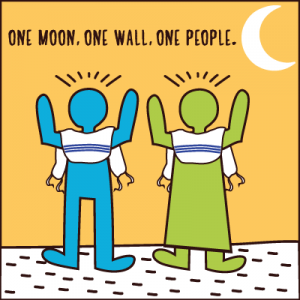 1- What the wall is and is not.
1- What the wall is and is not.
The Western Wall is a place of historic and religious importance to Jewish people all around the world. The last remaining remnant of a sacred religious site that our ancestors were forced to leave 2,000 years ago, it is a holy place for Jews worldwide and a place where people feel a special connection to God, to ancestors and to Jewish history.
The first organized prayers at the Western Wall took place in the 17th century, a time when Turkish forces ruled Jerusalem. Since that time, there has been ongoing tension regarding Jewish worship at the Wall. One of the most interesting stories about the Wall is one from 1928. Jewish worshippers attempted to set up chairs and a divider between men and women for Yom Kippur services at the Wall. The British troops reacted violently, breaking the divider. When the Jewish women tried to stop the troops, they were beaten with the wood of the divider. At the time, Muslims and Jews were arguing with the British government about access to the Wall. The Jewish People’s Council (Vaad Leumi) wrote to the British: “We herewith declare emphatically and sincerely that no Jew has ever thought of encroaching upon the rights of Moslems over their own Holy places, but our Arab brethren should also recognise the rights of Jews in regard to the places in Palestine which are holy to them.”
In 1967, when Israel took control of Jerusalem, a large plaza was built in front of the wall to hold tens of thousands of people. An Orthodox rabbi was then placed in control of the plaza and a divider was built to separate the men’s and women’s sections.
The plaza that is in front of the Wall is not a synagogue. The struggle for Women’s rights at the Wall is happening because the Wall is being treated as if it were a privately run Orthodox synagogue, rather than a public space that has special meaning to all Jewish people.
2 – America and Israel in dialogue
American Jews and Israeli Jews are in a dialogue with one another about what it means to be part of the Jewish people and how we will practice and celebrate Judaism wherever we may live. This means that American Jews have a lot to learn from Israelis, and vice-versa. Judaism is a conversation that goes both ways.
3 – Women and equality in Israel
In many societies, women experience political and economic freedom. Throughout history, however, women have experienced societal structures that have excluded them and made it difficult — and sometimes dangerous — to speak out. Israel is a place where women have political and economic freedom, but when women are told that they do not have equal access to a public place and are placed under restrictions that do not apply to men, we need to speak out.
4 – Judaism and human rights
Judaism has within it both teachings that affirm the rights and equality of women and teachings that relegate women to a status below that of men. Highlighting the countless stories in which women’s rights are affirmed and their voices are heeded, as well as the stories of women’s leadership within Jewish text, helps all Jews to see that we can balance tradition and modernity.
Want ideas about how to engage the tweens or teens in your community with the issue of Women of the Wall in a classroom or informal education setting? We have created a resource available to all Jewish educators. Please contact Sarah Fox, sfox@movingtraditions.org for a free copy.

